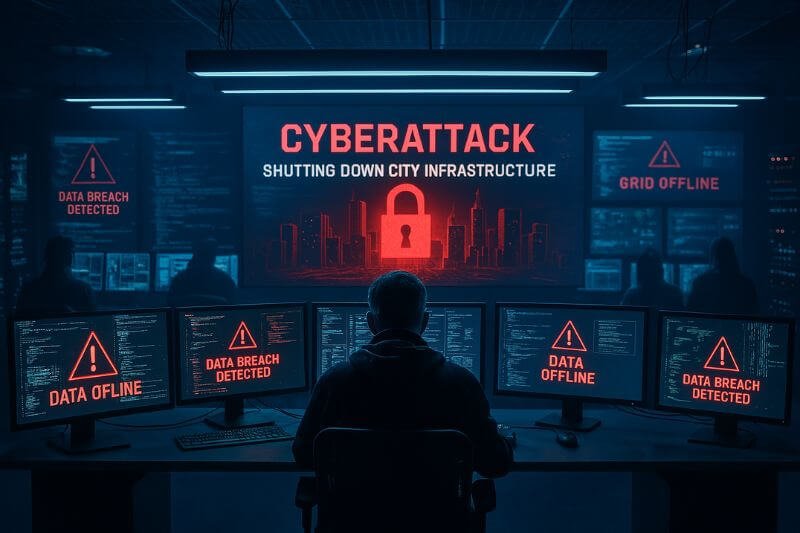Could a Digital Strike Collapse an Entire City?
The Next Blackout Won’t Be Caused by a Storm
No explosion. No sirens. No bombs dropping from the sky.
Just… darkness.
Hospitals go silent. Traffic lights blink out. Phones die. ATMs lock. The internet vanishes. And within hours, panic takes hold.
This isn’t science fiction—it’s the new frontline of warfare: cyberattacks on infrastructure.
Whether state-sponsored or rogue actors, the ability to digitally paralyze a city is now more than possible—it’s happening. From water plants in Florida to fuel pipelines in the U.S., critical infrastructure is under siege.
Survivalists must understand the risk, the patterns, and—most importantly—how to stay alive when the grid fails by design.
What Are Cyberattacks on Infrastructure?
Cyberattacks on infrastructure involve the deliberate targeting of essential services via digital means—often without physical violence.
Targets include:
- Power grids
- Water treatment plants
- Oil and gas pipelines
- Transportation systems
- Financial services
- Healthcare facilities
- Communications networks
These systems are often interconnected, outdated, and alarmingly vulnerable.
Real Attacks That Already Happened
This isn’t theoretical—it’s already begun.
🔹 Colonial Pipeline Attack (USA, 2021)
A ransomware attack forced the shutdown of a major U.S. fuel pipeline. Panic buying emptied gas stations across the East Coast for days.
🔹 Florida Water Plant Hack (2021)
Hackers attempted to poison the water supply by increasing sodium hydroxide levels 100x the safe limit. It was caught just in time.
🔹 Ukraine Power Grid Attack (2015–2016)
Russian-backed hackers shut down electricity to hundreds of thousands of homes—in the dead of winter.
🔹 NHS System Breach (UK, 2017)
The WannaCry ransomware halted emergency services, canceled surgeries, and locked out hospital systems.
Who Is Behind These Attacks?
- State actors (Russia, China, North Korea, Iran)
- Cybercriminal syndicates (e.g. DarkSide, Conti)
- Hacktivists and rogue insiders
- AI-powered automated malware (increasingly common)
And the most terrifying threat? Anyone with internet access and a few thousand dollars can now purchase ransomware-as-a-service kits on the dark web.
Why Infrastructure Is So Vulnerable
1. Outdated Technology
Many critical systems still run on:
- Windows XP or Windows 7
- Unpatched SCADA interfaces
- Legacy industrial software
2. Lack of Cybersecurity Funding
Public utilities and hospitals often lack IT staff, firewalls, or even basic encryption.
3. Remote Access Exploits
Smart grids and IoT devices have made systems convenient—but exposed.
4. Supply Chain Weakness
Attackers often infiltrate through third-party vendors with lower security standards.
Survivalist Scenarios: What Happens When a City Gets Digitally Shut Down?
When the grid goes down not from nature—but by design, it plays out differently:
⚠️ Power Outage (But No Storm)
- No warning
- No recovery crews
- No explanation
- Traffic chaos, silent hospitals, food rotting
⚠️ Water Contamination or Loss
- Pumps fail
- Alarms don’t trigger
- Taps run dry—or worse, poisonous
⚠️ Fuel Supply Lockdown
- No diesel = no trucks = no food in stores
- Gas stations disabled remotely
⚠️ Communication Collapse
- Phone networks jammed or infected
- Internet shut down
- Emergency alerts silenced
The Collapse Timeline (Digital Strike)
| Time | Consequences |
|---|---|
| 0–1 hour | Confusion, lights out, rumors spread |
| 1–6 hours | Panic buying, traffic gridlock, ATM failures |
| 6–24 hours | Looting, water shortage, police overwhelmed |
| Day 2–3 | Hospital crisis, gas outage, evacuations |
| Day 4+ | Martial law or societal fracture begins |
Cyber Blackout Survival Plan
Here’s how to prep for a man-made grid failure caused by cyber warfare:
1. Go Energy-Independent
✅ Install:
- Off-grid solar systems (battery + inverter)
- Hand-crank or pedal generators
- Backup fuel with manual pump
✅ Store:
- Propane or ethanol for cooking
- LED lanterns, rechargeable via USB solar
2. Protect Your Water Access
✅ Setup:
- Rain catchment with first-flush filters
- Hand-pumped well access
- 200+ gallons of storage in BPA-free containers
✅ Disinfect:
- Unscented bleach, AquaTabs, Berkey filters
💡 Don’t forget: Water pressure is often electric-pump powered
3. Harden Your Comms
✅ Equip:
- HAM radios (Baofeng, Kenwood)
- Solar-charged walkie-talkies
- Faraday bags to protect electronics
✅ Memorize:
- Local emergency frequencies
- Grid-down signal codes with your group
4. Secure Physical Access
When systems crash, so do:
- Bank access
- Gas pump payment terminals
- Store alarms and cameras
✅ Prepare:
- Hidden safes
- Analog locks (not smart systems)
- Barter items for trade
5. Stock Smart
✅ Include:
- Manual tools (can openers, pumps, saws)
- Paper maps and ledgers (offline backup)
- Preloaded flash drives with PDFs: survival guides, medical files, legal docs
6. Build Local Resilience Network
Digital failure = local-only life.
✅ Create:
- Neighborhood watch or prepper circles
- Barter list by skill and supply
- Protocols for comms, security, health, supply
When phones die, relationships keep you alive.
How to Tell If It’s a Cyberattack (Not Just a Blackout)
Look for:
- Power + water + internet all down simultaneously
- No emergency broadcasts
- ATM + POS machines showing ransomware messages
- Social media silence, phone outages
- Military or police radio traffic
Pro tip: Cyberattacks often start at 2–4 a.m. to delay detection.
Could This Happen at National Scale?
Absolutely.
The U.S. Government has warned:
- Power grid is a “prime target” for Russia and China
- National cyberdefense is “woefully underfunded”
- AI could automate multi-system takedowns
China has been accused of planting malware across U.S. infrastructure (water, transportation, military networks).
“It’s not a matter of if, but when.”
– Jen Easterly, Director of CISA (U.S. Cybersecurity & Infrastructure Security Agency)
What About Digital Currency and Finance?
CBDCs, digital wallets, and even traditional banks are fully digital now.
A successful cyberattack could:
- Freeze accounts
- Trigger ATM limits
- Erase transaction records
- Shut down payment terminals globally
Paper cash, precious metals, and offline barter will be your financial lifeline.
Conclusion: Prepare for a War That Doesn’t Explode—It Silences
Cyberattacks on infrastructure won’t look like war.
They’ll look like… confusion.
No signal. No receipts. No heat. No food.
Just people staring at black screens and wondering what’s next.
But survivalists won’t wonder. They’ll be ready—with power, water, comms, food, and community.
Prepare now. Because the next disaster won’t be natural.
It’ll be deliberate. Digital. And deadly quiet.















